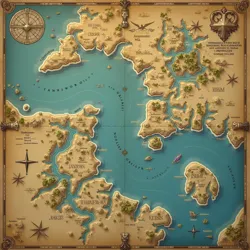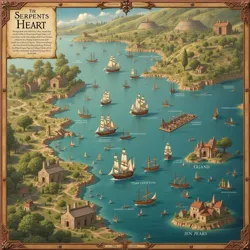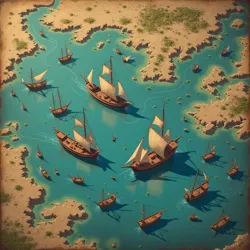The Contested Waters of the Serpent's Heart
 A 647 P.E. (Post-Emergence) map showing the major trade routes and contested territories of the Serpent's Heart Sea, preserved in the Grand Archives of Nyxhaven
A 647 P.E. (Post-Emergence) map showing the major trade routes and contested territories of the Serpent's Heart Sea, preserved in the Grand Archives of NyxhavenThe Serpent's Heart Sea is a vast inland body of water located in the center of the Meridian Continent, serving as the primary hub of commerce, cultural exchange, and political intrigue among the numerous nations that border its waters. Spanning approximately 800 leagues from east to west and 600 leagues from north to south, the sea earned its name from its serpentine shape and the ancient belief that it was formed by the coiling of the World Serpent during the First Age.
Geography and Climate
The Serpent's Heart Sea is connected to the Outer Ocean through the narrow Throat of Storms, a treacherous strait guarded by the imposing Twin Sentinel Fortresses of the Stormwatch Confederation. The sea's northern shores are characterized by dramatic fjords and rocky cliffs, while the southern coastline features numerous natural harbors and fertile river deltas. The eastern reaches are marked by the legendary Thousand Isles, an archipelago that serves as a haven for merchants, pirates, and political exiles alike.
The sea's unique position within the continent creates a moderate climate in the surrounding regions, with warm currents from the south meeting cooler northern waters. This convergence generates frequent morning mists and occasional severe storms, particularly during the Season of Tempests. The mixing of waters also results in extraordinarily rich fishing grounds, which have historically been a source of both prosperity and conflict among the coastal nations.
Historical Significance
Throughout recorded history, the Serpent's Heart has been the center of numerous attempts at dominion by various powers. The earliest documented conflict was the War of Pearled Crowns in 322 P.E., when three maritime kingdoms simultaneously claimed exclusive rights to the sea's strategic shipping lanes. This war established the precedent for the complex system of alliances and counter-alliances that would characterize the region's political landscape for centuries to come.
 A dramatic depiction of the Battle of Broken Masts, the decisive engagement of the War of Pearled Crowns, painted by Master Illustrator Galvan the Younger
A dramatic depiction of the Battle of Broken Masts, the decisive engagement of the War of Pearled Crowns, painted by Master Illustrator Galvan the YoungerThe most significant attempt at total control came during the reign of Emperor Malakai the Ambitious, who nearly succeeded in establishing complete dominion over the sea through a combination of military conquest and diplomatic manipulation. His eventual defeat by the Coalition of Free Ports in 891 P.E. led to the establishment of the Serpentine Accords, which continue to govern maritime law and trade relations to this day.
The Serpentine Accords
The Serpentine Accords represent one of the most complex diplomatic arrangements in known history. Established in 892 P.E., the Accords divide the sea into various zones of influence while maintaining open shipping lanes for all signatory nations. The document outlines specific rights and responsibilities for each participating power, including:
-
Designated fishing grounds and seasonal rotation systems
-
Shared responsibility for anti-piracy operations
-
Collective maintenance of navigation markers and lighthouses
The Accords are overseen by the Council of Tides, a neutral body headquartered in the free city of Port Equilibrium. The Council comprises representatives from all major coastal powers and meets biannually to address disputes and adjust regulations as needed.
Modern Politics and Secret Conflicts
While the Serpentine Accords maintain a facade of peace and cooperation, numerous undercurrents of tension persist beneath the surface. The Merchant Princes of Aureglass maintain a sophisticated network of informants throughout the coastal cities, while the Shadow Fleet of Obsidian Bay conducts clandestine operations to protect their interests. The Stormwatch Confederation uses its control over the Throat of Storms to exert political pressure, though they must maintain a delicate balance to avoid united opposition from other powers.
Recent years have seen the rise of the Guild of Seafarers, a powerful organization that officially represents the interests of independent captains and merchants. However, many suspect the Guild serves as a front for more ambitious political machinations, particularly given their growing influence in multiple coastal cities and their mysterious connections to the Veiled Court of the Thousand Isles.
Economic Importance
The Serpent's Heart serves as the primary trade route for countless commodities, from the Ghost-Silk of the northern kingdoms to the precious Sunfire Spices of the southern realms. The sea's rich fishing grounds provide sustenance for millions, while its pearl beds and coral reefs support luxury trades that have created countless fortunes.
 A trading galley from the Merchant Princes of Aureglass docked in Port Equilibrium during the annual Trade Summit
A trading galley from the Merchant Princes of Aureglass docked in Port Equilibrium during the annual Trade SummitMajor port cities have developed unique specializations, with Nyxhaven becoming the center of shipbuilding excellence, while Crimson Harbor dominates the spice trade. The Free Port of Mistral has emerged as the primary market for magical goods and artifacts, though this trade is carefully regulated under the Arcane Commerce Protocols established by the Council of Tides.
Cultural Impact
The Serpent's Heart has profoundly influenced the cultures of all surrounding nations. The Sea-Singers, a prestigious order of historian-bards, maintain oral histories of the sea's many legends and battles. The annual Festival of Floating Lights sees thousands of lanterns released across the waters, commemorating those lost at sea and celebrating the prosperity the waters bring.
Maritime traditions have evolved into complex social customs, particularly in the art of Sea-Courtesy, an intricate system of etiquette that helps maintain peace between vessels from different nations. The practice of Wave-Speaking, a sophisticated system of flag signals and light flashes, has developed into an art form beyond its practical applications.
Environmental Concerns
Despite its importance, the Serpent's Heart faces numerous challenges. The Great Coral Decline of recent decades has alarmed many scholars, while increasing traffic in certain shipping lanes has led to concerns about the impact on marine life. The Order of the Azure Depths, a coalition of scholars and maritime druids, works to study and protect the sea's ecosystem, though their efforts often conflict with commercial interests.
The mysterious phenomenon known as the Midnight Tide, where portions of the sea appear to glow with an eerie blue light, has become more frequent in recent years. Some scholars link this to changing patterns in the deep currents, while others suspect more sinister causes related to ancient magics stirring in the depths.
Legacy and Future
The Serpent's Heart continues to be a crucial nexus of power, commerce, and culture. While the Serpentine Accords have prevented open warfare for centuries, the increasing complexity of international relations and the emergence of new powers threaten to upset the delicate balance. The recent discovery of Deeplight Crystals in the southern waters has sparked renewed interest in controlling strategic portions of the sea, leading many to wonder if the current peace can endure.
As maritime technology advances and new trade routes are established, the sea's significance only grows. The Cartographers' Conclave continues to map its changing currents and hidden dangers, while the Mariners' College in Port Equilibrium trains new generations in the arts of navigation and sea-law. Whether the waters will remain free for all or fall under the dominion of a single power remains one of the great questions of the age, as the ancient cycles of alliance and betrayal continue to shape the destiny of all who dwell along its shores.